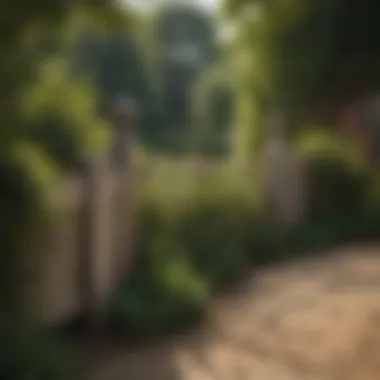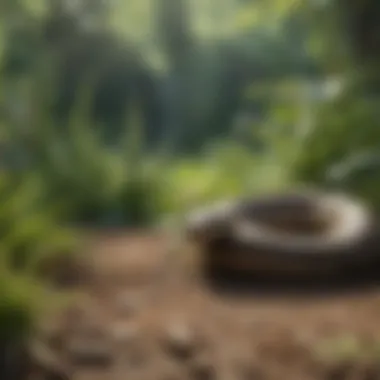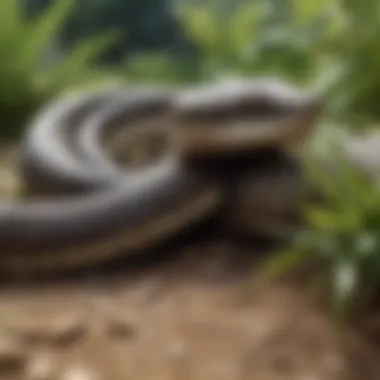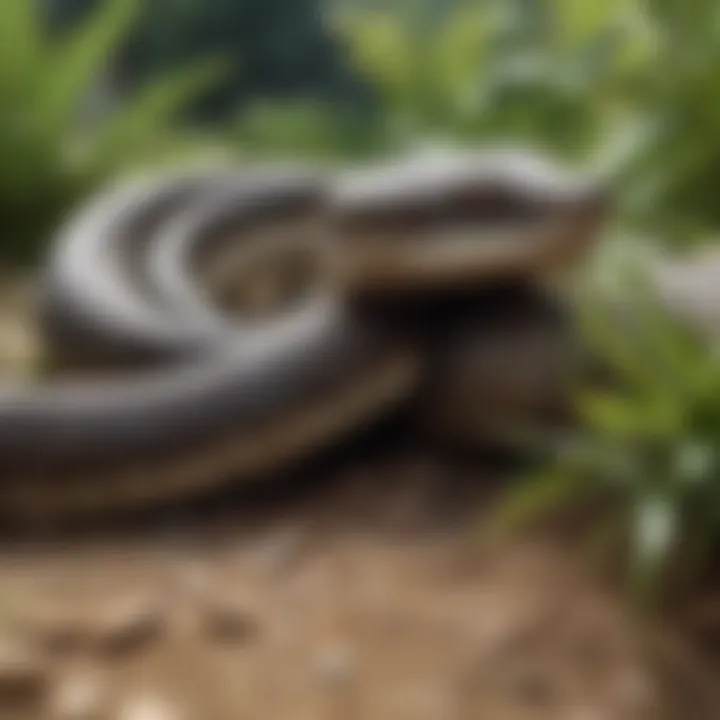Proven Techniques to Deter Snakes in Your Garden


Intro
Garden snakes often earn a bad rap, seen more as pests than the beneficial creatures they can be. Homeowners and gardeners alike sometimes find themselves in a low-grade panic when they spot these reptiles slithering through their yards. Yet, understanding the nature of those garden snakes can provide some much-needed peace of mind. Not only do they play a crucial role in controlling pests like rodents, but they also help maintain a balanced ecosystem. In this article, we'll explore effective strategies to repel snakes while maintaining respect for their ecological role.
What you will find here are practical and humane strategies, ranging from simple environmental modifications to ingenious physical barriers. We will also delve into various natural repellents that may steer these snakes away without causing them harm. By equipping homeowners and those with a green thumb with effective tools and knowledge, the hope is to create a safe and welcoming outdoor environment—one that keeps both humans and garden snakes content.
Understanding the Pest
Identification
To effectively manage the presence of garden snakes, the first step is recognizing them. The most common garden snake species include the garter snake, rat snake, and king snake. Each of these species has its own unique characteristics. For instance, the garter snake usually has a distinctive stripe running down its back, while rat snakes can boast a more solid color.
Identifying these snakes is important; many species are harmless and even beneficial. Most garden snakes tend to be non-venomous, but a fleeting encounter with some species can still be unnerving. A little knowledge goes a long way in alleviating fears—learning what they look like can help you differentiate between those that are beneficial and those that are potentially harmful.
Life Cycle
Understanding the life cycle of garden snakes further enhances your ability to manage them. Generally, snakes undergo a series of developmental stages, starting from eggs or live births, depending on the species. Most common garden snakes hatch from eggs and can be seen in warmer months, as they are often active in spring and summer.
As they mature, they begin to move away from their birthplace in search of food and habitat suitable for breeding. This migration phase is when they often invade residential yards, searching for shelter or prey.
Pest Prevention Strategies
Environment Modification
Creating an unfavorable environment for snakes is an essential part of keeping them at bay. Here are some common modifications to consider:
- Maintaining a Trimmed Landscape: Regularly mow your lawn and trim back shrubs. Unkempt grass and dense vegetation provide ideal hiding places for snakes.
- Enhancing Sunlight Exposure: Snakes typically prefer shaded areas, so increasing sunlight exposure in your garden can deter them. Remove debris like piles of rocks or wood that may offer shelter.
- Controlling Water Sources: Snakes are attracted to areas with abundant water. Fix any leaks around outdoor fixtures and consider draining stagnant ponds or birdbaths that are not frequently cleaned.
Physical Barriers
Sometimes the best defense is a good offense. Implementing physical barriers will discourage snakes from taking up residence:
- Fencing: Install a snake-proof fence that stands at least four feet high and is buried six inches underground. This can create a solid line of defense.
- Natural Mullch: Creating a buffer zone of coarse gravel or stone around the perimeter of your garden can discourage snakes from entering, as they dislike traversing rough textures.
Control Methods
Chemical Control
While chemical repellents exist, many contain harsh substances that might not be ideal for maintaining a healthy garden environment. It’s important to choose environmentally friendly options if you choose to go this route. Some natural deterrents include:
- Cinnamon Oil: Sprinkling cinnamon oil in garden areas may ward off garden snakes without harming them.
- Vinegar Solutions: Spraying vinegar around potential entry points in your yard may also help.
Biological Control
Using the natural prey of garden snakes to your advantage can help keep their population in check. Encourage birds of prey or other natural predators into your area. Planting specific species known to attract these birds can turn your yard into a sanctuary for natural snake control.
"Working with nature, instead of against it, is often the most effective method of pest control."
Understanding Garden Snakes
Understanding garden snakes is crucial for anyone with a garden or property where these creatures might roam. It's not just about getting rid of them; it's about recognizing their role in the ecosystem and knowing how to coexist with them, if possible. Garden snakes play a significant part in natural pest control, eating rodents and insects that may damage your flowers and vegetables. By grasping their behaviors and needs, homeowners can implement effective strategies that won’t just repel snakes, but also create a more balanced garden environment.
Behavioral Patterns of Garden Snakes
Garden snakes are generally shy and tend not to seek out human interaction. They prefer to avoid disturbances and will only react defensively when they feel threatened. Often, their behavior centers on seeking out warmth and shelter. In the sunlight, you might catch one basking on a rock, which is normal for their thermoregulatory habits.
These snakes tend to be opportunistic eaters, often hunting small mammals or even birds, depending on what’s available. By being active during dawn and dusk, they maximize their chances of encountering prey while also avoiding some natural predators themselves. Recognizing these patterns can help in determining the best methods to deter them from your space, making it easier to anticipate when they might be around.
Roles in the Ecosystem
In gardens, snakes play important roles. They are often considered indicators of a healthy ecosystem. Many gardeners might believe they only cause trouble, but in truth, they help manage populations of various pests. Their presence can mean that your garden supports a diverse food chain, making it more resilient.
For example, by controlling the population of rodents, snakes help reduce the number of animals that could potentially harm your plants through nibbling. Additionally, they are food for larger wildlife, thus supporting the ecosystem further. In many cases, these snakes are performing tasks that go unnoticed until problems arise, emphasizing the importance of understanding their ecological contributions.


Common Species Found in Gardens
When discussing garden snakes, it’s valuable to know which species tend to show up in residential areas. Common types include:
- Gartersnakes: Often striped, they thrive in a variety of habitats and are non-venomous.
- Rat snakes: Wise hunters, they are good climbers and typically seek prey in trees and shrubs.
- Corn snakes: Recognizable by their vibrant colors, they tend to be quite benign and actually help reduce rodent populations.
Identifying these species can significantly influence how you manage their presence in your garden. Knowing their specific behavior and diet allows for more nuanced strategies to encourage them to find alternative habitats without resorting to harsh measures.
Understanding your garden’s visitors can help form strategies that are both humane and effective to keep them at bay.
Identifying Snake Presence
Understanding the presence of snakes in your garden is a crucial step in managing their activities. Knowing whether these creatures are around can help prevent potential surprises and minimize risks to your garden and your peace of mind. Snakes often go unnoticed until they slither by, leaving you startled. Hence, being able to identify their presence becomes not just a matter of curiosity but a practical necessity if you wish to keep your garden thriving and safe.
Signs of Snake Activity
When it comes to discerning if snakes are roaming your territory, there are notable signs you should be on the lookout for:
- Slithering Tracks: Observing snake tracks can be a dead giveaway. They leave distinct patterns in soft soil or mulch that can help you identify the direction they are moving.
- Shedding Skin: If you find shed scales, consider it a clear signal that snakes have made themselves at home. Anticipate this especially during warmer seasons when snakes are more active.
- Feces: Snake droppings look like dark pellets or striations and can often contain undigested remains of their prey. Spotting these can alert you to their recent activity in your area.
- Sound: Keep an ear out for peculiar rustling or slithering sounds, particularly when nearing shrubs or dense plants, which can indicate snake movement.
- Sightings: Perhaps the most obvious is actually seeing the snake. Quick basks in the sun or sudden darting can reveal their presence directly.
Knowing the signs of snake activity not only helps in identifying their presence, but also enhances your ability to implement appropriate repelling strategies.
Understanding Their Habitat Preferences
Not all snakes fancy the same havens. Snakes typically gravitate towards environments that suit their needs. Here’s what to consider:
- Shelter: Snakes often seek cover among tall grasses, heaps of leaves, or piles of rocks. Understanding that they prefer abundant hiding spots can help you assess your garden for potential snake-friendly sites.
- Water Sources: Many snake species are drawn to gardens with standing water or frequent moisture. If you have a pond or a birdbath, this could attract them.
- Prey Availability: Gardens teeming with rodents or insects can be like an all-you-can-eat buffet for snakes. If you spot a surge in pests, you might also see an uptick in snake visits as they come to hunt.
- Temperature Preferences: Warm, sunny areas are especially appealing to snakes, as they rely on external heat sources to regulate their body temperature. Areas that get lots of sun, particularly near walls or rocks, can act as basking spots.
In short, understanding where snakes prefer to dwell can be immensely helpful. Not all snakes are harmful, but recognizing their patterns, habits, and signs of activity ensures that you can keep potential encounters at bay while allowing your garden to thrive.
Physical Barriers
Utilizing physical barriers is a frontline strategy for homeowners seeking to deter garden snakes from their property. Such barriers not only help prevent the snakes from entering your garden but can also serve as a long-term solution to keep them away. This approach brings peace of mind, especially for those who may have young children or pets that could accidentally come across these slithering creatures. Here’s a closer look at some specific methods that can be employed.
Fencing Solutions
Types of Fencing Materials
When considering fencing as a solution, the types of materials you choose play a vital role in the effectiveness of the barrier. Common options include wood, chain link, and wire mesh. Wire mesh is particularly beneficial due to its sturdiness and flexibility; it provides a physical deterrent that snakes find difficult to breach. Moreover, wire mesh can come in various gauges, allowing for customization based on the level of snake activity in your area. However, it's worth noting that thinner materials may wear down over time, leading to potential weakness in the fence.
One unique feature of wire mesh is its ability to adapt to the terrain, making it suitable for uneven ground. Conversely, wooden fences can offer aesthetic appeal but may require regular maintenance to ensure that gaps or rot do not compromise their effectiveness. In short, selecting the right material comes down to balancing practicality with aesthetic preferences.
Recommended Heights and Designs
The height and design of the fencing are just as critical as the materials used. A general recommendation is to ensure your fence stands at least three feet tall. This height acts as a strong deterrent for most common garden snakes, which typically do not climb well. Angled tops or barriers can be even more effective. An inward tilt at the top of your fence could throw off a snake's attempt to scale it.
Additionally, a solid design without spaces at the bottom can prevent snakes from slipping through. One factor to keep in mind is that taller fences may require sturdier posts and foundational support, which could increase costs. Ultimately, a well-designed fence strikes a balance—effective against snakes while maintaining an inviting look for your garden.
Creating Unfriendly Environments
Creating conditions that are less hospitable to snakes is another effective strategy in repelling them.
Removing Debris and Hiding Spots
Snakes often seek refuge in cool, damp spots, making the removal of debris essential. This includes clearing away piles of leaves, wood, and even long grasses that accumulate over time. A clean garden acts as a barrier not just to snakes but also to other pests. In essence, maintaining a tidy outdoor space limits the number of suitable hiding places available.
For instance, removing stacked rocks or old garden tools that may have been left out can significantly reduce potential snake habitats. Additionally, keeping a regular schedule for yard maintenance—like raking and trimming—can further enhance these efforts. The result? A space that creates a clear message to snakes: this is not their home.
Proper Landscaping Techniques
Landscaping can both beautify your garden and deter snakes at the same time. By selecting native plants that emit scents snakes find unappealing, like lavender and marigolds, you can send them packing. Another effective technique is to keep bushes trimmed and maintain distance between plants, which reduces shaded areas where snakes may seek shelter.
It's crucial to consider drainage as well. Ensure that water cannot pool in the garden as snakes are often attracted to moisture. By lowering the likelihood of standing water, you decrease the chances of attracting other wildlife that snakes might prey upon, thereby making your garden less attractive overall. Thoughtful plant placement and smart landscaping can be essential components in your overall snake-repelling strategy.


Natural Repellents
Natural repellents offer an appealing and eco-friendly approach to keeping garden snakes at bay. These methods not only minimize the use of harsh chemicals but also provide a more harmonious way to coexist with the local wildlife. By understanding which natural substances can deter snakes, homeowners can create an environment that's less inviting for these creatures without resorting to extreme measures.
Key Benefits of Natural Repellents:
- Safety for Humans and Pets: Unlike chemical alternatives, natural remedies typically pose fewer risks to family members and pets.
- Eco-Friendly Solutions: These methods tend to be biodegradable and cause less harm to the environment compared to chemical pesticides.
- Sustainable Practices: Utilizing plants and essential oils encourages a holistic approach to gardening and landscaping.
It's essential to explore various natural options, understanding their benefits and limitations.
Using Essential Oils
Essential oils are a potent natural tool for repelling snakes, known for their strong scents, which tend to deter these animals.
Recommended Oils for Repellents
Some of the most effective essential oils include:
- Clove Oil: Known for its pungent aroma, clove oil has been found to be particularly effective at warding off snakes.
- Cinnamon Oil: This oil not only smells great to humans but works wonders in making snakes think twice before entering a treated area.
- Lemongrass Oil: The fresh lemon scent is pleasant for people but unwelcoming for snakes.
These oils are beneficial choices because they create a barrier without causing harm to the creatures or the ecosystem. Their unique feature lies in their versatility, being suitable for various applications, from sprays to diffusers. However, keep in mind that the effectiveness can be influenced by weather conditions, making regular reapplication necessary.
Application Methods
When it comes to applying essential oils, a few common practices can bring about the best results:
- Diluted Sprays: Mixing essential oils with water or a carrier oil creates a spray that can be easily applied to areas frequented by snakes.
- Soaking Cotton Balls: Placing cotton balls soaked in essential oils near entry points serves as a discreet repellent.
The key characteristic of these methods lies in their simplicity and ease of use. They provide an effective way to maintain a snake-free zone without extensive effort. However, it is crucial to reapply these methods regularly, especially after rain or heavy watering.
Planting Specific Herbs
Integrating certain herbs into your garden can also work wonders in deterring snakes. These plants produce strong scents that disturb the snakes’ environment, prompting them to seek refuge elsewhere.
Herbs That Deter Snakes
Several herbs known for their repellent qualities include:
- Mint: Not only does it add a refreshing scent, but mint’s aroma serves to confuse snakes.
- Garlic: This herb has a potent smell that is off-putting to many creatures, including snakes.
- Rosemary: Besides adding flavor to dishes, rosemary’s strong scent can deter snakes effectively.
These herbs are advantageous because they can thrive in many climates, providing both aesthetic appeal and practical benefits. Moreover, their dual purpose of culinary use makes them a thoughtful choice for any garden.
Tips for Garden Integration
When considering how to integrate these herbs into your existing garden layout, here are some practical tips:
- Strategic Placement: Planting herbs around the perimeter of the garden acts as a natural barrier.
- Companion Planting: Combining herbs with other flowers and plants can enhance their growth while providing additional repelling effects.
These tips are ideal choices for maximising garden space while enhancing its defensive properties against unwanted snakes. The unique feature of this approach is that it blends seamlessly into any garden environment, offering beautification alongside functionality.
Ultimately, leveraging both essential oils and specific herbs creates a holistic strategy. As you adopt these natural repellents, remember to observe the garden's ecosystem, ensuring that you are fostering balance while achieving your protective goals.
Chemical Repellents
Chemical repellents serve as a crucial component in the broader discussion of keeping garden snakes at bay. Unlike other methods that might rely on natural barriers or environmental modifications, chemical solutions often provide a more immediate and concentrated approach to snake repellence. They can create an inhospitable environment for snakes, making it uninviting for them to enter your garden. Chemical repellents can be especially beneficial in areas where snakes are prevalent and traditional deterrent methods fall short. When considered appropriately, they can enhance your overall garden strategy, providing a layered defense against unwanted visitors.
Evaluating Commercial Products
Active Ingredients to Look For
When choosing a commercial snake repellent, one of the key aspects to inspect is its active ingredients. Commonly found compounds like naphthalene, sulfur, and essential oils (such as cinnamon or clove oil) are often emphasized. Naphthalene, for instance, is notable for its strong odor that is distasteful to snakes. Its characteristic pungency acts as a potent deterrent, making it a popular choice among homeowners seeking effective solutions. Meanwhile, essential oils offer a more natural alternative, often favored for their environmental compatibility and pleasant fragrances for humans. However, these natural options may require frequent reapplication due to their volatile nature.
Each ingredient has its own unique attributes that can influence its effectiveness and practicality in different situations. For example, naphthalene is effective but perhaps not the safest choice for families with pets or small children. Therefore, one must weigh the relative advantages and disadvantages of each product type.


Best Practices for Use
To maximize the efficacy of chemical repellents, following best practices is paramount. First off, always read the manufacturer's instructions carefully. Correct application involves not only knowing how much to use but also understanding the timing and frequency of application for the best results. Moreover, targeting specific areas where snakes are likely to appear, such as near foundations or dense vegetation, can significantly increase success rates.
Another essential point is to maintain the treated areas. Rain or irrigation can diminish the product's effectiveness, requiring you to reapply more often than one might anticipate. A strategy that incorporates diligent maintenance ensures the repellents maintain their potency. Balance is key here: too much application might harm plants or create an overly chemical environment in your garden.
Safety Considerations
While the aims of using chemical repellents are straightforward, safety should never be overshadowed. First and foremost, be aware of the presence of pets or small children in your vicinity. Many chemical repellents can pose health risks if ingested or inhaled. It’s crucial to store these products securely and away from household areas to prevent accidental exposure.
Also, consider checking local regulations regarding the use of certain chemicals in outdoor spaces. Some communities have restrictions on certain active ingredients, particularly when it concerns wildlife interaction. The last thing any homeowner wants is to create a harmful environment for beneficial animal species in an effort to repel garden snakes. Always be informed before applying these products to ensure the safety of all critters—wild and domestic.
Community and Environmental Considerations
Understanding how snake repelling efforts intersect with community dynamics and environmental health is vital. When individuals in residential areas invest time and resources in methods to keep snakes at bay, it affects not only their immediate surroundings but also the broader ecosystem. By addressing these aspects, we can promote safer, more effective strategies that benefit all involved.
Human-Snake Interactions
The relationship between humans and snakes is often fraught with misunderstanding. Many people see snakes as pests, creating an immediate sense of fear or threat. However, this view overlooks the fact that snakes play an essential role in controlling pest populations. Their presence can actually lead to a healthier garden environment by keeping rodents and insects at manageable levels.
Typically, when humans encounter snakes in their gardens, it's often due to their natural hunting patterns or seasonal migration. Recognizing this could change the way we perceive these creatures. Creating educational community workshops can help alleviate fears and provide insights into how to handle encounters safely and responsibly.
For instance, teaching neighbors not to panic when they see a snake can promote coexistence. Understanding the basic behavioral patterns can also lead to better-informed decisions on when and how to use specific strategies to deter snakes without harming them.
Ecological Impact of Repelling Techniques
When deploying methods to repel snakes, it is crucial to consider their ecological impact. Many common repellents, whether chemical or natural, may unintentionally disrupt local ecosystems.
- Natural Measures: Natural repellents, like essential oils and specific plants, can deter snakes while allowing other wildlife to thrive. For example, planting marigolds not only looks lovely but can also help deter snakes without causing harm to the ecosystem.
- Chemical Repellents: In contrast, chemical solutions may kill beneficial insects or affect soil quality. Before using such products, one should verify the specific active ingredients and their potential consequences on plants and other animals.
The community must weigh the benefits and drawbacks before adopting a particular method. Here are some questions to consider:
- What other wildlife might be affected by the chosen method?
- Is the solution sustainable in the long term?
- Are there regulations in place regarding the use of certain chemicals in residential areas?
Promoting awareness that some methods may adversely affect local ecosystems fosters a more responsible approach to snake management.
Understanding the balance between protecting homes and maintaining ecological integrity is crucial for community sustainability.
For a long-lasting effect, involving both homeowners and local environmental organizations can create a network of support and resources. This collaboration encourages community engagement in finding solutions that are effective yet environmentally sound. Such cooperative efforts not only improve efficacy but also enhance knowledge about local wildlife, fostering a healthier relationship with nature.
Debunking Myths About Snakes
Understanding the various myths that surround snakes is crucial when tackling the issue of their presence in gardens. Misconceptions can lead to fear, unnecessary harm to these reptiles, and even misguided actions that do not effectively resolve the problem of snake encounters. It’s essential to separate fact from fiction to approach snake management with a rational mindset. This will not only help in repelling them effectively but also promote a harmonious environment where humans and wildlife can coexist.
Common Misconceptions
Several myths about snakes tend to cloud our judgment. Some common beliefs include that all snakes are venomous and that they attack humans without provocation. Here are some prevalent misconceptions:
- All Snakes Are Dangerous: While snakes do belong to a variety of species, the vast majority are non-venomous and largely beneficial to gardens as they help control pests.
- Snakes Chase People: In reality, snakes are more inclined to avoid humans. They do not chase after people but rather retreat when confronted. This behavior helps them stay safe from potential threats.
- Garden Snakes Destroy Plants: Many assume that garden snakes feast on horticulture, but these creatures primarily consume rodents and insects, which means they actually assist in maintaining a healthy ecosystem.
Dispelling these misconceptions fosters a more balanced appreciation of snakes and mitigates unwarranted fear. Knowledge empowers garden owners to handle snake situations effectively while minimizing harm to wildlife.
Understanding Real Risks
It's vital to acknowledge the real risks associated with snakes, rather than blanket assumptions based on fear.
- Venomous vs. Non-Venomous Snakes: In most regions, only a handful of snake species are venomous, such as the copperhead or rattlesnake. Familiarizing yourself with local species can help in identifying potentially dangerous snakes versus harmless ones. Online resources such as Wikipedia and reputable sites can aid in species identification.
- Frequency of Encounters: While the thought of snakes slithering through the garden can cause anxiety, actual interactions are rare. If encountered, it’s essential to remain calm, as sudden movements can provoke a defensive response.
- Ecological Contribution: Snakes can be an integral part of the ecosystem. They help regulate rodent populations that could otherwise devastate other plants in the garden. Understanding their role highlights the need for a balanced approach to garden management.
Ending
Understanding the importance of effective garden management cannot be overstated in creating a harmonious coexistence with nature, particularly when it comes to managing garden snakes. The strategies outlined in this article shed light on how to not only repel garden snakes but do so in a manner that is thoughtful and humane. By understanding their behavior, integrating natural repellents, and utilizing physical barriers, homeowners can cultivate a safe and welcoming environment while minimizing negative encounters with these reptiles.
Best Practices for Garden Management
In all aspects of garden management, clear, consistent practices should be highlighted. Here are some best practices that can aid in effectively managing your garden while keeping garden snakes at bay:
- Maintain a clean garden: Regularly clear debris, as piles of leaves and unnecessary clutter can create ideal hiding spots for snakes. Keeping the garden tidy is akin to putting your best foot forward; it sends a signal that the area is well-maintained and not conducive for snakes to take refuge.
- Consider your landscaping: Certain plants, like the marigold or garlic, can serve dual purposes in aesthetics and natural deterrence. Being intentional with plant selections helps shape not just the look but the environment effectively.
- Secure your trash: Open waste bins invite unwelcome guests, including snakes. Use tight-fitting lids and consider keeping garbage in a shed if possible to avoid attracting unwanted creatures.
- Educate your family: As they say, knowledge is power. Family members should be informed about snake safety—what to do if one is spotted and how to recognize signs of their presence.
- Regularly check for holes: Ensure that any gaps in fences, walls, or entryways are minimal. Snakes can slither through surprisingly small openings, so staying vigilant can help fortify your defenses.
By implementing these strategies, homeowners can rest assured that they are employing sensible, effective means to repel garden snakes while still allowing nature to flourish in their outdoor spaces. A proactive approach not only minimizes risks but also enhances the overall experience of maintaining a thriving garden.







